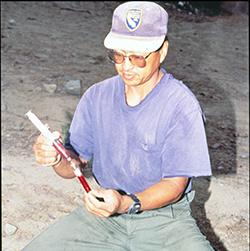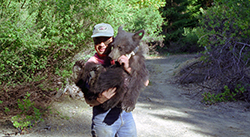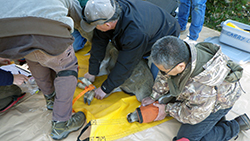


In 2013, Stuart Itoga became CDFW’s deer program coordinator, which means he is responsible for understanding, managing and conserving California’s deer populations. An avid outdoorsman, Stuart was born in Chicago and raised in San Jose. He holds a degree in Wildlife Management from Humboldt State University.
Stuart first joined the department in 1995 as a scientific aide at the Butte Valley Wildlife Area in Siskiyou County after holding fisheries and wildlife positions with the U.S. Forest Service. He is now a senior environmental scientist.
California is home to both mule and black-tailed deer, both resident and migratory herds that wander more than 70 percent of the state and number about 500,000 animals. At the dawn of the state’s 2017 deer hunting season (the general season opens Sept. 16 in many parts of the state), Stuart shared some personal background and his professional outlook on the state of deer management and deer hunting in California.
Who or what inspired your love of natural resources?
I always liked being outside, but hunting and fishing with friends really did it for me.
What do you like best about your job?
I get to work with so many great people. I work with scientists from other state agencies, and it’s enlightening to discuss different conservation approaches with other agency staff. But working on deer projects with our scientists is the best part. They really care about conserving deer and our other natural resources. It hasn’t all been good, but working together, we’ve been able to do some really good things over the past few years. I like the direction we’re headed.
Are you a deer hunter yourself?
I am – or I used to be, at least. When I started this job as the deer program coordinator, I thought it might help me figure out where the best spots were, but this job keeps me so busy I just haven’t made the time to get out deer hunting the past few years. It doesn’t look like I’ll get out there this season either.
Hunters often remark that California’s deer seasons start too early, and that overall hunter success would be much better if the seasons started later in the year, closer to the rut as is the case in many other states. What do you think?
We could start seasons later, which likely would result in greater levels of harvest that couldn’t be sustained over the long term. This would mean fewer tags for hunters. Having some early seasons allows us to provide tags to a greater number of hunters. Our hunter survey overwhelmingly indicated that hunters prized just the opportunity to get out and hunt deer. So we try to provide a balance of opportunity and high-quality hunts. You may not get the hunt you really want in a given year, but you will be able to get a tag to hunt somewhere.
There are very limited doe hunting opportunities in California compared to other states. Wouldn’t providing more doe hunts not only improve hunter success but also help improve the overall health of California’s herds by removing some older does no longer able to reproduce?
Doe hunts are typically conducted to reduce deer density and negative impacts to the herd and the habitat that result from too many deer. We are currently updating our baseline population data with new methods that allow us to estimate deer populations with a greater level of precision and accuracy. We are assessing where we might be seeing high-density impact at work. There are some areas where the densities are around 12 deer per square kilometer and others about four. The question we’re looking at now is how many deer are sustainable over the long term and what the appropriate levels of harvest – male and female – need to be.
Going back to our survey, 85 percent of hunters supported a doe hunt if data indicated it was warranted. However, having the supporting data and the support of hunters is only part of the equation. In California and other Western states, doe hunts are not widely supported by the non-hunting public, and 37 of California’s 58 counties can veto the department’s recommendations for antlerless hunts.
Mountain lions are another sore subject for many deer hunters. They often get blamed for suppressing California’s deer numbers. To what degree are mountain lions impacting California’s deer herds?
Mountain lions are deer predators as are bear, coyotes, bobcats and people. We’re updating our baseline deer population numbers, which will help us determine the level of significance associated with lion and other predation. Without a good starting number, it’s impossible to tell what impact lions – or other predators – are having on deer populations. In addition to our population study with deer, the department is assessing the mountain lion population, which will also provide valuable information on deer-lion interactions.
I personally think the number of people in the state may be the biggest stressor on deer populations. A population of almost 40 million people has quite an impact on the state’s natural resources.
What’s one message you’d like to share with deer hunters as they prepare to head out this season?
One thing I hear with some consistency is, “There are no bucks.” Our trail cameras and fecal DNA studies, however, are showing us there are.
We conducted a hunter survey a couple of years ago as part of an update of our California Deer Conservation and Management Plan. That survey, combined with the level of effort information we get from the harvest reports submitted by hunters, tell us the average California deer hunter spends about eight days in the field. That’s a good deal of time and effort. So I’m not saying it’s easy to get a buck, but hunters that are consistently successful put some effort into their hunt and also spend time scouting beforehand. If you can get out before your trip and pattern the deer, you’re going to increase your chances of being successful.
Good luck to all of our deer hunters this year! If you’re successful, send me a photo at stuart.itoga@wildlife.ca.gov. (Don’t forget to tag it first!)